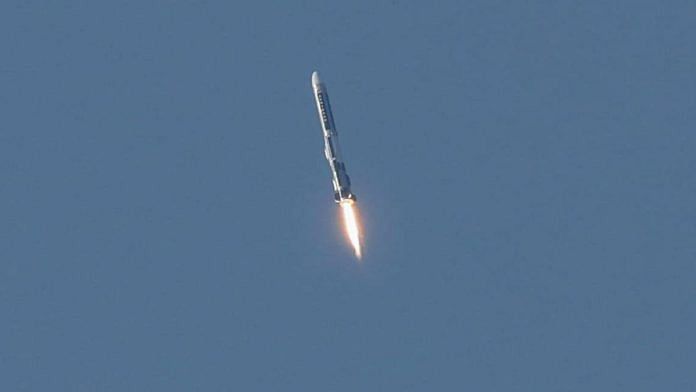New Delhi: Chennai-based space startup AgniKul Cosmos Thursday successfully test-launched India’s first semi-cryogenic rocket — Agnibaan SOrTeD (Sub Orbital Technology Demonstrator) — after four of its previous attempts had failed.
“Humbled to announce the successful completion of our first flight — Mission 01 of Agnibaan SOrTeD — from our own and India’s first and only private launchpad within SDSC-SHAR (Satish Dhawan Space Centre, Sriharikota Range) at Sriharikota,” the company later said in a statement.
“All the vehicle was completely designed in-house and powered by the world’s first single piece 3D-printed engine and also happens to be India’s first flight with a semi-cryo engine,” it added.
The government space agency, Indian Space Research Organisation (ISRO), has not yet launched a semi-cryogenic rocket, making AgniKul Cosmos the first in India to venture into this sphere, albeit with ISRO’s technical support. After the launch Thursday, ISRO congratulated Agnikul Cosmos for achieving “a major milestone”.
AgniKul Cosmos is an Indian Institute of Technology-Madras incubated venture founded in 2017 by Srinath Ravichandran, Moin S.P.M., and S.R. Chakravarthy. It was the first Indian company to sign an agreement with ISRO in 2020 and is one of the heaviest-funded space startups in the country.
Also read: Mission with India to search for water on moon is on track, launch in few years — Japan space agency
‘Historic milestone’
Agnibaan is a single-stage launch rocket powered by an Agnilet semi-cryogenic engine, i.e., an engine fuelled by a combination of liquid and gaseous propellants. A semi-cryogenic engine remains at temperatures higher than cryogenic but colder than traditional liquid rocket engines.
A semi-cryogenic engine also can provide more thrust to rockets, helping carry higher payloads than cryogenic engines running on only gaseous propellants. So, Agnibaan paves the way for heavy-lift capability rockets, marking a significant development in India’s space sector. Moreover, semi-cryogenic rockets are environment-friendly and cost-effective.
ISRO is now developing a 2,000 kN thrust semi-cryogenic engine, with its latest trial conducted 2 May this year.
Agnibaan has other features that make it a key achievement. A plug-and-play engine configuration would allow the precise tailoring of the rocket to meet mission objectives and adjustments to fit commercial requirements. This feature makes Agnibaan, which would be available for commercial use, versatile, with a potential for various applications.
Agnikul Cosmos has also pointed out that Agnibaan, unlike conventional rockets launched from guide rails, will lift off vertically and follow a predetermined trajectory while performing a precisely orchestrated set of manoeuvres during flight.
A.K. Bhatt, director general of the Indian Space Association (ISpA), said the successful test launch was “nothing short of a historic milestone since India launched its maiden rocket in 1963 from the Thumba launch station (in Kerala’s Thiruvananthapuram)”.
“This is a huge boost and a proud moment for India’s thriving private space industry and just a glimpse into what the future holds for us,” he said.
“This significant launch, coupled with the recently introduced guidelines for implementing the Indian Space Policy 2023 by IN-SPACe and the new FDI (foreign direct investment) regulations, will bolster global confidence in India’s private space industry and growing capabilities,” he added.
Also read: Paving way for all-weather & all-time imaging, Bengaluru space firm tests SAR on HAPS platform
Semi-cryogenic engines as future of space travel
ISRO is also making strides in developing its first semi-cryogenic engine to ensure more efficient future launches. Early this month, the space agency conducted the first ignition trial for its SCE-200 (semi-cryogenic engine-200) at the Semi-cryo Integrated Engine Test (SIET) facility at the ISRO Propulsion Complex (IPRC) in Mahendragiri, Tamil Nadu.
The test demonstrated smooth and sustained ignition of the pre-burner, a vital step in starting the semi-cryogenic engine. The SCE-200 is a 2MN thrust class liquid rocket engine developed by ISRO’s Liquid Propulsion Systems Centre (LPSC).
This next-generation rocket engine, designed to enhance the payload capability of ISRO’s Launch Vehicle Mark-III launcher and future launch vehicles, operates on an oxidiser-rich staged combustion cycle using liquid oxygen (LOX) and RP-1 (rocket propellent-1) kerosene.
Speaking to ThePrint, senior ISRO scientists said the SCE-200 will likely replace the currently used L110 stage, also known as the core stage of the LVM-3. It promises to power future launch vehicles, such as the upcoming next-generation launch vehicles and reusable launch vehicles.
Four failed attempts before success
This is not the first time that AgniKul Cosmos has attempted the launch. There have been four previous tries at liftoff since March this year. The last was an attempt two days ago.
On 28 May, the launch was scheduled for 5.45 am but got delayed due to an undisclosed technical glitch during the countdown, with the liftoff rescheduled for 9.25 am. However, with just five seconds to launch, the AgniKul Cosmos team put the mission temporarily on hold to assess igniter performance. The company, however, did not clarify the exact reason behind the rescheduling.
Earlier on 7 April, a communication issue arose between two of the launcher’s onboard hardware.
“Had to call off today’s launch attempt of Agnibaan SOrTeD just a second into Automated Launch Sequence (ALS) initiation (at T-129 seconds) because of a communication issue between two of our onboard hardware. Although it is frustrating to see a hold this close to lift off, we are glad our ALS did its job. We’ll get to the root cause and come back for the launch after fixing the cause,” Agnikul Cosmos, at the time, said.
Senior officials from ISRO, which has been providing technical support to the private company, told ThePrint that such delays are normal, especially when attempting tests for a novel technology.
(Edited by Madhurita Goswami)
Also read: Why has desilting of Rajasthan’s Bisalpur Dam become point of contention between govt & activists






